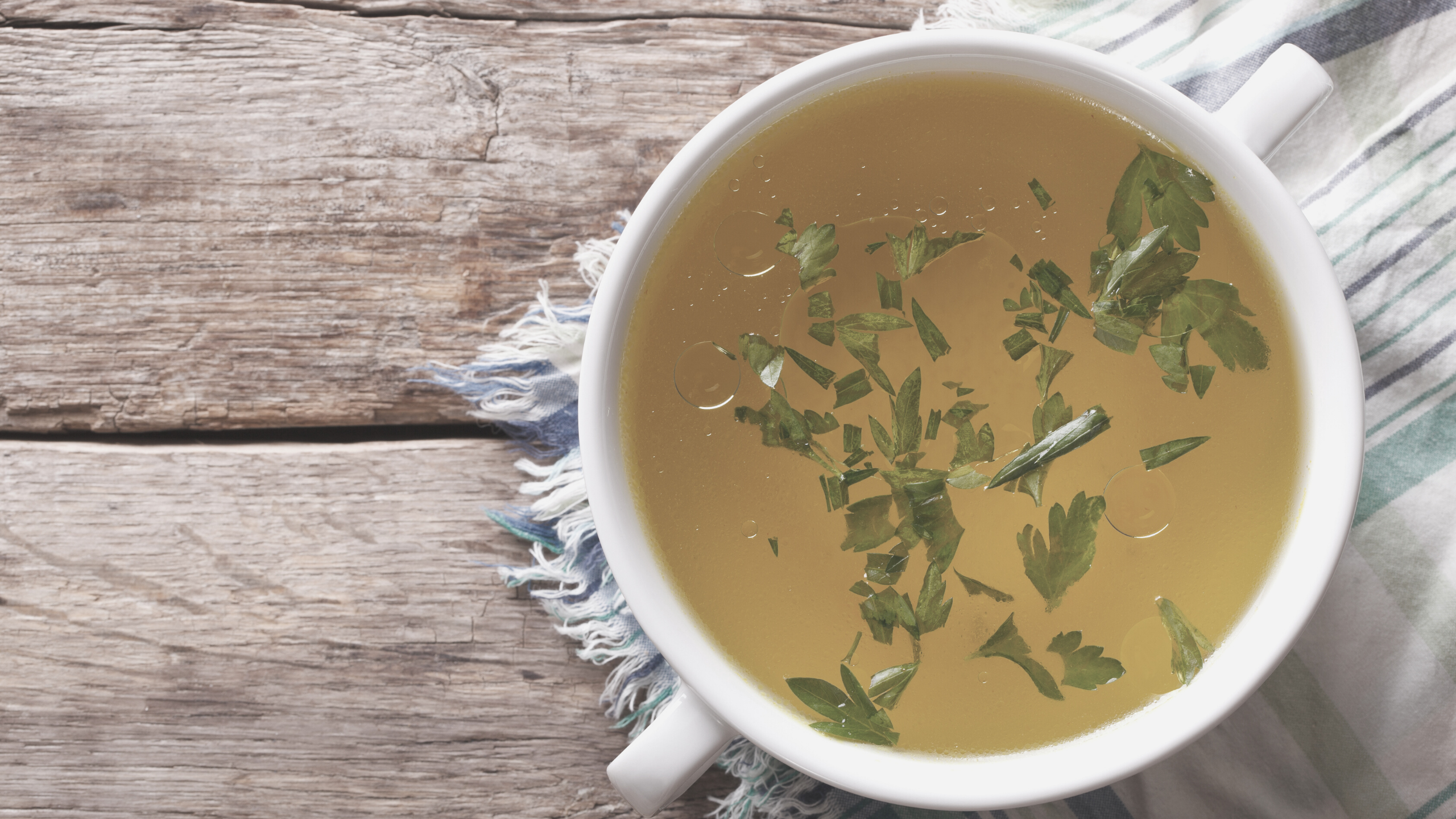Bone broth isn’t just warm and soothing, it’s an emotionally restorative powerhouse of gut repairing nutrients and body strengthening amino acids.
It is foundational to any restorative diet (a diet that provides the nutrition and nourishment required to support emotional healing and restore emotional well-being) – which is exactly what I advocate during a season of healing.
What does a restorative diet look like and why is it so important? Learn all about it in my HEAL YOUR HEART PROGRAM
I first discovered bone broth in Fiji on a mission trip in 2005. After our meal, the leftover bones, feet, and carcasses of the chickens we ate that night (the ones killed that day and cooked underground with hot rocks) were thrown into a GIANT stock pot and cooked in water overnight and the broth was made into the best golden curry I ever ate the next morning for breakfast.
It was my first exposure to using EVERY part of the animal and letting nothing go to waste. My curiosity was peaked. I asked tons of questions. Were the bones just for flavor or did they have nutritional value? If so, what kind? How do you know? Who taught you to cook this way?
I went home and started doing even more research. That’s how I found Sally Fallon’s book Nourishing Traditions (which has become one of my favorite cookbooks) where I learned about time-tested, healing foods like broth.
I’m so thankful I did because after Aubrey and Ellie died I leaned on this information to help heal myself – body and soul.
What’s so healing about broth?
In the simplest terms, broth is nutritious AND comforting, two essential qualities of an emotional well-being food.
Nutritionally, bone broth is high in collagen protein and vegetable broth is high in minerals, but it’s most important superpower is its ability to comfort and nourish at the same time.
I’m not sure how much scientific proof there is for the benefits of broth, but my own experience and hundreds of years of use all validate it’s place at the top of my healing foods list.
Broth is the easiest healing food to make by far. It’s a convenient, inexpensive, and versatile addition to an emotionally supportive nutrition program (ie. a restorative diet).
Bone broths, meat broths, and vegetable broths have built me back up from my lowest point and continue to nourish my body and soul today. I can’t imagine healing without them.
I’ve learned a thing or two about making bone broth since I’ve done it a bazillion times. I’ve certainly made lackluster broth in the past and my mistakes have taught me how to get it right.
It’s important that broth is as delicious as it is nutritious. Broth that tastes great makes consuming such a powerful healing food an enjoyable, sustainable practice.
Here are a few tips to make your broth rich, flavorful, and as beneficial as possible:
Use Organic Bones. The higher the quality of the bones, the more beneficial the broth. If I was able, I’d raise or hunt my own meat, but since I live in a townhouse in the suburbs, I buy organic as often as possible. If I can’t find organic I buy halal, kosher, or wild.
Do your best to buy the best quality bones you can. Commercially raised animals contain a lot of heavy metals that are dangerous for our bodies. Consider this when purchasing meat and bones.
Roast your bones before you make broth out of them. It is possible to make bone broth from raw bones, but it will lack flavor, color, and clarity.
You’ll also have to skim a lot of ‘scum’ off the top of the broth a few times as it simmers. This isn’t the end of the world, you’ll have to skim a little scum no matter what, but really scummy broth grosses me out, so I prefer cooked bones to raw.
The roasting process cooks off most of the stuff that makes scummy broth. To roast your bones, spread them on a sheet pan and place in a 350-degree oven for 45 min. For a faster roasting, use a 425-degree oven for 25-30 min.
Make sure to check on them. You want to roast them, not burn them. Burnt bones make bitter broth. If you are using bones from meat you’ve already cooked, like the carcass of a baked chicken, for example, you don’t have to cook the bones again.
Use only one kind of animal bones. Mixing bones from different animals together creates a broth that can’t decide what it wants to taste like and ends up tasting muddled. For the best broth pick one kind of bone and diversify the veggies and herbs to change up the flavor.
Don’t let your broth boil. Boiling emulsifies the fat and degenerated proteins in the bones with the water and makes it cloudy. While broth can vary in clarity, boiling will make it look like someone poured milk into it.
You can still use it, but it won’t be as appealing or tasty. Personally, I’m not a fan of cloudy broth. I like a clear broth with a smooth mouthfeel.
Use filtered water. Tap water varies from city to city. Water treatment makes water safe for use, but doesn’t make it ideal for drinking.
Tap water is treated with a number of chemicals in order to kill bacteria and other microorganisms. It can contain chlorine, fluorine compounds, trihalomethanes, salts of arsenic, lead, mercury, hormones, nitrates, and pesticides.
Not only are these chemicals and heavy metals bad for your health and emotional well-being, but they will also make your broth taste yucky. Who wants chlorine flavored broth? Not me.
Now finally, the recipe:
I included a meat broth and a bone broth version. Everyone has different tolerances and you should only consume foods that make you feel good.
If bone broth doesn’t sit right with you, meat broth is a great alternatives with the same comforting powers. If a vegetable broth appeals to you more, I have a recipe in my free healing recipe ebook HERE.
Personally, chicken feet are my favorite to make an non-vegetarian broth. They are inexpensive, roast well, have a lovely flavor, and gel up well when the broth cools which is what you want because that means the collagen proteins are abundant in the broth.
I made the recipes scalable (cut it in half or double it easily) so you can make as little or as much broth as you like and I included stovetop, slow cooker, and Instant Pot instructions.
I like to cook using time-tested basic methods, but not too many rules, so this recipe is intended to be just enough structure to give you broth-making wings but not overwhelm you with nine-hundred steps. Use the recipe as a guideline, not law. There is a lot of freedom in broth-making.
The sky is truly the limit with broth. I’ve also included three flavor variations for your broth enjoyment at the end. I hope they encourage you to see just how enjoyable and versatile adding broth to your diet regularly can be.
Basic Bone Broth
- 2 lbs bones or 1 pound meat (roasting optional) or 1 pound chicken feet, roasted
- 1 cup onion, chopped
- 1 cup celery, chopped
- 1 cup carrots, chopped
- 2 tablespoons Apple Cider Vinegar
- 2 bay leaves
- 1 tsp good quality salt (you can add more salt later if needed)
- 12 cups filtered water
Stovetop: Place bones/meat/chicken feet, vegetables, vinegar, bay leaves, and salt into a large stockpot. Add filtered water. Cover and place on medium-high heat until it begins to simmer. Turn heat down to low to maintain a low simmer. You don’t want your bones just sitting in hot water but you don’t want them boiling either. Allow simmering, covered, for 12-24 hours. Let cool and strain. Store broth in the refrigerator for a week or freeze for up to 6 months.
Slow cooker: Place bones/mean/chicken feet, vegetables, vinegar, bay leaves, and salt into the slow cooker crock. Add filtered water. It’s ok if it can’t hold all 12 cups. Just add as much water as you slow cooker can hold. Cover and place on high until it begins to bubble. Turn to low to allow a calm simmer. Allow simmering, covered, for 24 hours. Let cool and strain. Store broth in the refrigerator for a week or freeze for up to 6 months.
Instant Pot: Depending on the size of your instant pot, you may want to half the recipe. Place bones, vegetables, vinegar, bay leaves, and salt into your instant pot. Add filtered water. Use only as much as your Instant Pot allows. Don’t worry if it can hold all 12 cups. Place lid on and secure into place. Choose the broth setting and set time for 3 hours for chicken bones, meat, or feet, 4 hours for beef bones or meat. After the pressure has self-released, allow broth to cool, and strain. Store in the refrigerator for a week or freeze for up to 6 months.
Flavor Variations:
- Tomato and Herb Bone Broth: Add 1-2 fresh tomatos, 2 garlic cloves, 1 tsp of dried thyme, and 1 tsp of dried parsley to the pot before cooking.
- Mushroom Ginger Bone Broth: Add 1/2 cup dried mushrooms or 1 cup fresh mushrooms and a half-inch knob of fresh ginger root to the pot before cooking.
- Spicy Bone Broth: Add 1 fresh jalapeno pepper (seeds removed if you don’t want it really spicy), 1 tsp smoked paprika, and 1 tsp dried oregano before cooking.
Would you like more FREE healing recipes?
How do you make your broth?
Email me at Rachel@thegriefgal.com and let me know.


Add a comment
0 Comments